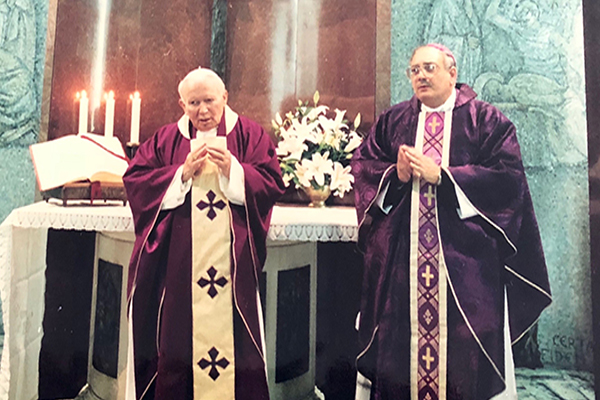
My dear brothers and sisters in the Lord,
On May 18, we commemorated the 100th Anniversary of the birth of Karol Wojtyla, who became Pope John Paul II, and now St. John Paul II. I would like to share my reflection about St. John Paul II and me. First of all, I must say that I always had great admiration for his person and certainly for his accomplishments. In his ministry as a Pope, I once wrote a paper about him for delivery at a conference entitled, “The Migrant Pope.”
In it, I described not only his migration from Poland to Rome but also his many trips around the world, which created a new understanding of what the Papacy means in the Church as he came closer and closer to the people. His institution of the World Youth Days, which were a tremendous success in the past and continue now after his death, show how John Paul II wanted to capture the energy of the young people of the world.
On a personal note, Pope John Paul II appointed me as Auxiliary Bishop of Newark in September of 1996, Bishop of Camden in July of 1999, and Bishop of Brooklyn on August 1, 2003. Each of these opportunities for me to serve the Church came to me through a man whom I admired, especially for his sanctity.
There are two special times that I remember that are truly close to me. The first occurred during a trip to the Vatican. It was the custom of the Holy Father to invite guests to his morning Mass in his private chapel at the Vatican, and priests were invited to concelebrate. Any visiting bishop who was present concelebrated at the Altar with the Holy Father. The day I was present occurred on a weekday in Lent during my tenure as Bishop of Camden.
There was no other bishop present, so it was he and I alone at the Altar. Before the Mass began, all were able to enter the chapel and be with the Holy Father as he meditated. His meditation, from external appearance, was much more than just prayer. He seemed to be in another realm of being. His face was aglow with a certain feeling that could only be his communication with God Himself.
During the special Liturgy, which I never will forget, one could see the devotion with which he celebrated Mass. At that time, the Holy Father was still very mobile and was able to give great meaning to the Liturgy. Much later in his pontificate, at our Ad Limina visit, two months before his death, my second remembrance occurred. The Ad Limina visits had been much curtailed, as previous visits with John Paul II contained not only a private meeting with each bishop in attendance but also included a lunch with all of the bishops present from a particular region. These lunches truly were enjoyable meals where the Holy Father entertained us with his jokes, which showed his keen understanding of the situation of the world and the Church.
But this last Ad Limina visit was more somber. Pope John Paul II was in the last stages of the affliction of Parkinson’s disease. His face was motionless, and he was seated in a chair with something in front of him to hold, allowing him to sit comfortably. His personal secretary, Archbishop Stanislaw Dziwisz, told me that the Holy Father would ask oneword questions and I would respond.
This perhaps was the longest 15 minutes of my life. For example, the Holy Father would say a word, “education,” and I would tell him about the situation of Catholic education in the Diocese of Brooklyn. Then he might say, “religious,” and I would speak about our religious. And so on and so on. Although the questions were oneworded, I would clearly see that he was listening intently to what I was telling him about our Diocese in Brooklyn and Queens. How could one who was so close to death still have such devotion to duty?
I could see that this time the Holy Father was suffering, suffering from his inability to communicate and from the disease itself. Certainly, the memory of this occasion is one that I will never forget. When the announcement was made of the death of Pope John Paul II on April 2, 2005, it was done is a unique way. A cardinal came out and simply said, “He has gone home to the Father’s House.” What a wonderful way to explain death for one who believes in Jesus Christ. For we believe the words that Jesus told us Himself, that He was going to the Father’s House to prepare a place for us.
Pope John Paul II certainly put out into the deep waters of human history. We know for certain that there is a place for this saint in the Father’s House. And now as we celebrate the 100th Anniversary of his birth, we celebrate as the Polish people do who sing not ‘Happy Birthday” but rather “Sto lat, niechaj zyja nam,” may you live 100 years. We know that St. John Paul II has not only come to his one hundred years, but we also know that he lives eternally in the Father’s House. We seek the intercession of St. John Paul II on this his birthday in Heaven for the Church today so much in need of the wisdom with which he guided her for more than 26 years.
